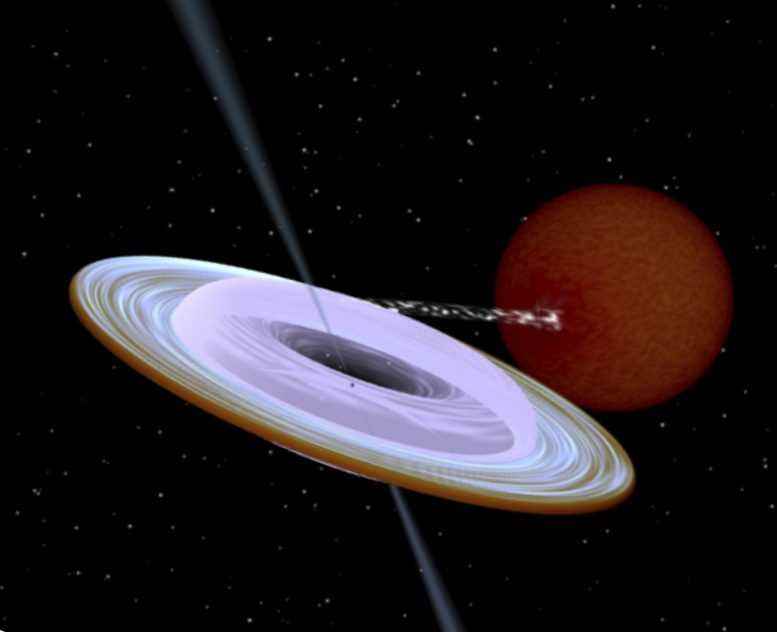Finlandiya’daki Turku Üniversitesi’nden araştırmacılar, bir dönme ekseninin[{” attribute=””>black hole in a binary system is tilted more than 40 degrees relative to the axis of stellar orbit. The finding challenges current theoretical models of black hole formation.
The observation by the researchers from Tuorla Observatory in Finland is the first reliable measurement that shows a large difference between the axis of rotation of a black hole and the axis of a binary system orbit. The difference between the axes measured by the researchers in a binary star system called MAXI J1820+070 was more than 40 degrees.

Artist impression of the X-ray binary system MAXI J1820+070 containing a black hole (small black dot at the center of the gaseous disk) and a companion star. A narrow jet is directed along the black hole spin axis, which is strongly misaligned from the rotation axis of the orbit. Image produced with Binsim. Credit: R. Hynes
Often for the space systems with smaller objects orbiting around the central massive body, the own rotation axis of this body is to a high degree aligned with the rotation axis of its satellites. This is true also for our solar system: the planets orbit around the Sun in a plane, which roughly coincides with the equatorial plane of the Sun. The inclination of the Sun rotation axis with respect to orbital axis of the Earth is only seven degrees.
“The expectation of alignment, to a large degree, does not hold for the bizarre objects such as black hole X-ray binaries. The black holes in these systems were formed as a result of a cosmic cataclysm – the collapse of a massive star. Now we see the black hole dragging matter from the nearby, lighter companion star orbiting around it. We see bright optical and X-ray radiation as the last sigh of the infalling material, and also radio emission from the relativistic jets expelled from the system,” says Juri Poutanen, Professor of Astronomy at the University of Turku and the lead author of the publication.
Bir kara delik (gazlı diskin merkezindeki küçük kara nokta) ve ona eşlik eden bir yıldız içeren X-ışını ikili sistemi MAXI J1820+070’in sanatçı izlenimi. Yörüngenin dönme ekseninden büyük ölçüde yanlış hizalanmış olan kara delik dönüş ekseni boyunca dar bir jet yönlendirilir. Binsim ile üretilmiş görsel. Kredi bilgileri: R. Hynes
Bu jetleri takip eden araştırmacılar, kara deliğin dönme ekseninin yönünü çok doğru bir şekilde belirleyebildiler. Daha sonra yoldaş yıldızdan kara deliğe düşen gaz miktarı azalmaya başladığında, sistem karardı ve sistemdeki ışığın çoğu yoldaş yıldızdan geldi. Bu şekilde, araştırmacılar yörünge eğimini spektroskopik teknikler kullanarak ölçebildiler ve bu, fırlatmaların eğimi ile neredeyse çakıştı.
“Yörüngenin 3 boyutlu yönünü belirlemek için, ayrıca sistemin gökyüzündeki konum açısının, yani sistemin gökyüzünde kuzey yönüne göre nasıl döndürüldüğünün bilinmesi gerekir. Bu, polarimetrik teknikler kullanılarak ölçüldü” diyor Juri Poutanen.
Science dergisinde yayınlanan sonuçlar, kara delik oluşumu ve bu tür sistemlerin evrimi çalışmalarına yönelik ilginç perspektifler ortaya koyuyor, çünkü birçok kara delik oluşumu ve ikili evrim senaryosunda bu tür aşırı yanlış hizalamayı elde etmek zor.
“Yörünge ekseni ile kara delik dönüşü arasındaki 40 dereceden fazla fark tamamen beklenmedikti. Bilim adamları, maddenin davranışını bir kara deliğin etrafındaki eğri bir zaman uzayında modellediklerinde, bu farkın genellikle çok küçük olduğunu varsaydılar. Mevcut modeller zaten gerçekten karmaşık ve şimdi yeni bulgular bizi onlara yeni bir boyut eklemeye zorluyor,” diyor Poutanen.
Referans: Juri Poutanen, Alexandra Veledina, Andrei V. Berdyugin, Svetlana V. Berdyugina, Helen Jermak, Peter G. Jonker, Jari JE Kajava, İlia A. Kosenkov, Vadim Kravtsov, Vilppu Piirola, Manisha Shrestha, Manuel A. Perez Torres ve Sergey S. Tsygankov, 24 Şubat 2022, Bilim.
DOI: 10.1126/science.abl4679
En önemli bulgu, Turku Üniversitesi ile ortaklaşa sahip olduğu Nordic Optical Telescope’a monte edilen, şirket içi yerleşik polarimetrik alet DIPol-UF kullanılarak yapıldı. Aarhus Üniversitesi Danimarka’da.

